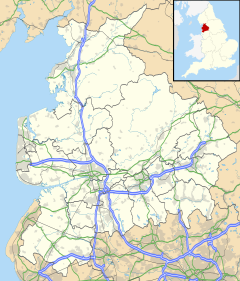The North Western Railway (NWR) was an early British railway company in the north-west of England. It was commonly known as the "Little" North Western Railway, to distinguish it from the larger London and North Western Railway (LNWR).

The Morecambe branch line is a railway line in Lancashire, England, from Lancaster to Morecambe and Heysham, where trains connect with ferries to Douglas, Isle of Man. To reach Heysham, trains must reverse at Morecambe.
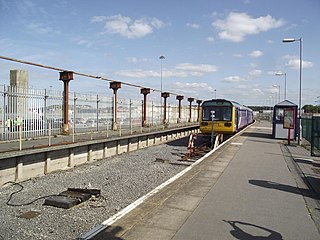
Heysham Port is a railway station on the Morecambe Branch Line, which runs between Lancaster and Heysham Port. The station, situated 7+3⁄4 miles (12 km) west of Lancaster, serves Heysham Port in Lancashire. It is owned by Network Rail and managed by Northern Trains.

The Furness and Midland Joint Railway was a joint railway in England owned by the Furness Railway and the Midland Railway. Construction was agreed in 1862 for a line from Carnforth, on the Furness system, to Wennington, on the Midland Railway line from Yorkshire to Morecambe. Royal assent was received in June 1863 and the contract for the route was let to Benton & Woodiwiss soon after at a cost of some £102,850.

Hellifield is a railway station on the Bentham Line, which runs between Leeds and Morecambe via Skipton. The station, situated 36 miles 17 chains (58.3 km) north-west of Leeds, serves the village of Hellifield, Craven in North Yorkshire, England. It is owned by Network Rail and managed by Northern Trains.
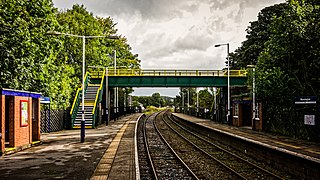
Wennington is a railway station on the Bentham Line, which runs between Leeds and Morecambe via Skipton. The station, situated 15+3⁄4 miles (25 km) east of Lancaster, serves the village of Wennington in Lancashire. It is owned by Network Rail and managed by Northern Trains.

Coniston railway station was the northern terminus of the Coniston branch line in the village of Coniston, Lancashire, England.

Tebay railway station was situated on the Lancaster and Carlisle Railway (L&CR) between Lancaster and Penrith. It served the village of Tebay, Cumbria, England. The station opened in 1852, and closed on 1 July 1968.
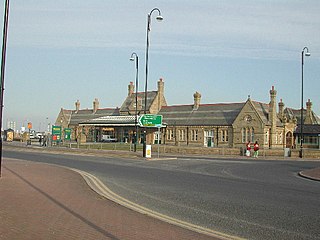
Morecambe Promenade Station was a railway station in Morecambe, Lancashire, England. It was opened on 24 March 1907 by the Midland Railway and closed in February 1994. After twelve weeks break in passenger service for the revision of track work and signalling a new Morecambe station was opened on a site closer to the town centre.

Claughton is a small village and civil parish in the City of Lancaster in Lancashire, England. The village is on the A683 road east of Lancaster and at the time of the 2001 census had a population of 132. In the 2011 census Claughton was grouped with Roeburndale to give a total of 223.

Lancaster Green Ayre railway station was the Midland Railway's station in the city of Lancaster in England. The line between Green Ayre and Morecambe was used for pioneering experimental electrification via overhead wires.
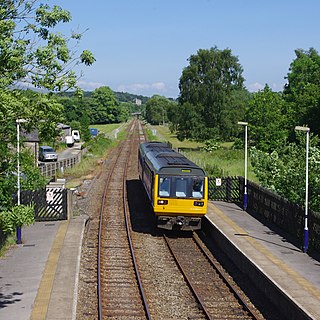
The Leeds–Morecambe line, also known as the Bentham line, is a railway line running between Leeds, Skipton, Lancaster and Morecambe in northern England. The service is operated by Northern. The route covered by the service was historically part of the Midland Railway. The line is electrified at 25 kV AC overhead between Leeds City and Skipton- this section is known as the Airedale line.

Morecambe Euston Road was the terminus station of the London and North Western Railway's branch line to Morecambe, in Lancashire, England. It closed in 1962, after which all trains to Morecambe used the nearby Morecambe Promenade station.

Bullgill or Bull Gill was a railway station on the Maryport and Carlisle Railway (M&CR) serving Bullgill in Cumbria. The station was opened by the M&CR in 1840 and lay in the Parish of Oughterside and Allerby. It closed in 1960

Borwick railway station formerly served the village of Borwick in Lancashire, England. It was located on the Furness and Midland Joint Railway line between Carnforth and Wennington, 3 miles (5 km) east of Carnforth Joint station.
Crook railway station served the town of Crook, County Durham, England. It was located on the Bishop Auckland and Weardale Railway line from Bishop Auckland to Blackhill between Wear Valley Junction and Tow Law, 17 miles (27 km) north west of Darlington.

Wray railway station was a short-lived station near the village of Wray in the City of Lancaster district of Lancashire, England. The station was opened on a temporary basis by the "Little" North Western Railway on their route between Skipton and Lancaster, and was closed after just ten months of operation in the summer of 1850. The station was a single-building cottage and was administered by John Bee until 1891.
Claughton railway station served the village of Claughton in the City of Lancaster district of Lancashire, England.
Caton railway station served the village of Caton in the City of Lancaster district of Lancashire, England.

The Clayton West branch line was a standard gauge passenger and freight railway near Huddersfield, in West Yorkshire, England. The line was built by the Lancashire and Yorkshire Railway, opening to traffic in September 1879. Many proposals were considered to extending the line eastwards towards Darton, and then connecting to Barnsley, but these never came to fruition. In 1963, both stations on the line,, were listed for closure under the Beeching cuts, but the branch survived as a passenger carrying railway until 1983. The branch also forwarded coal from two collieries adjacent to the line, which maintained a freight service on the branch up until closure.


